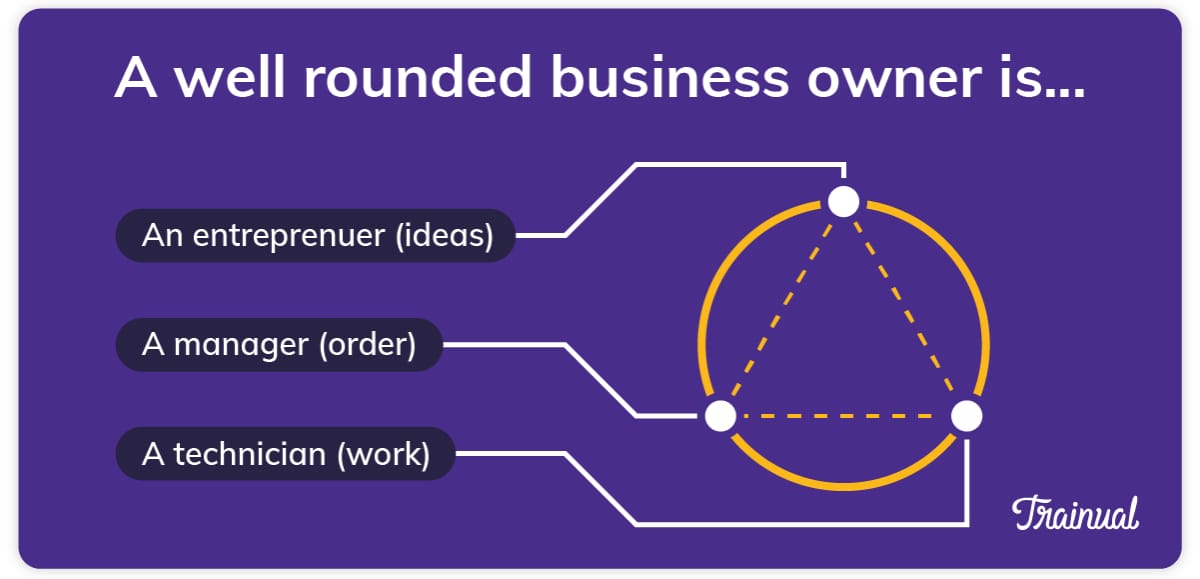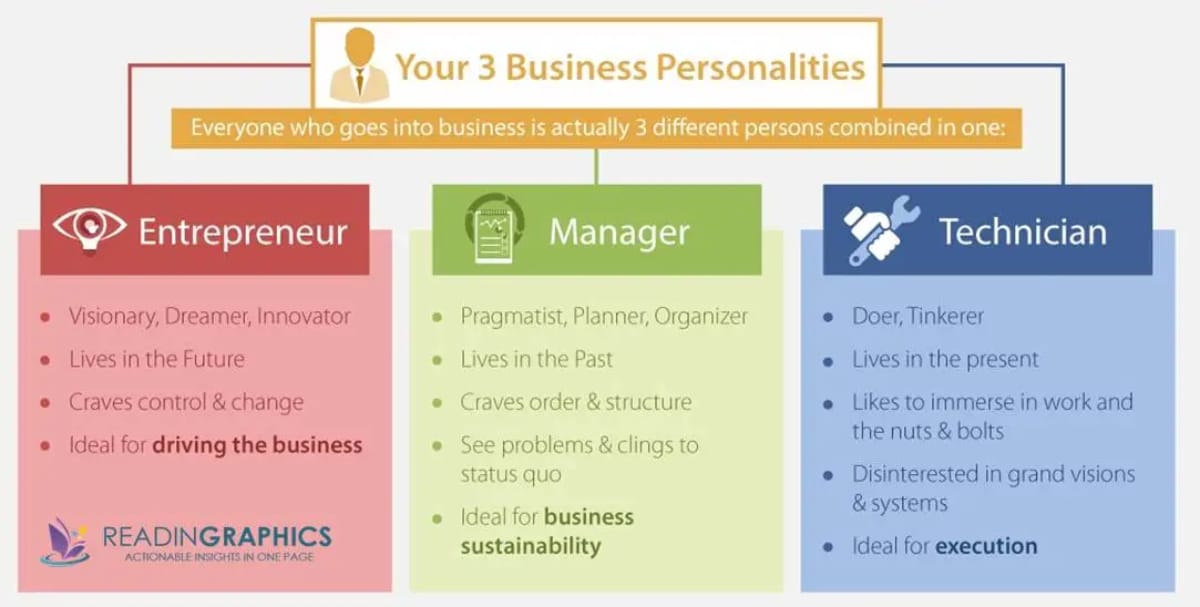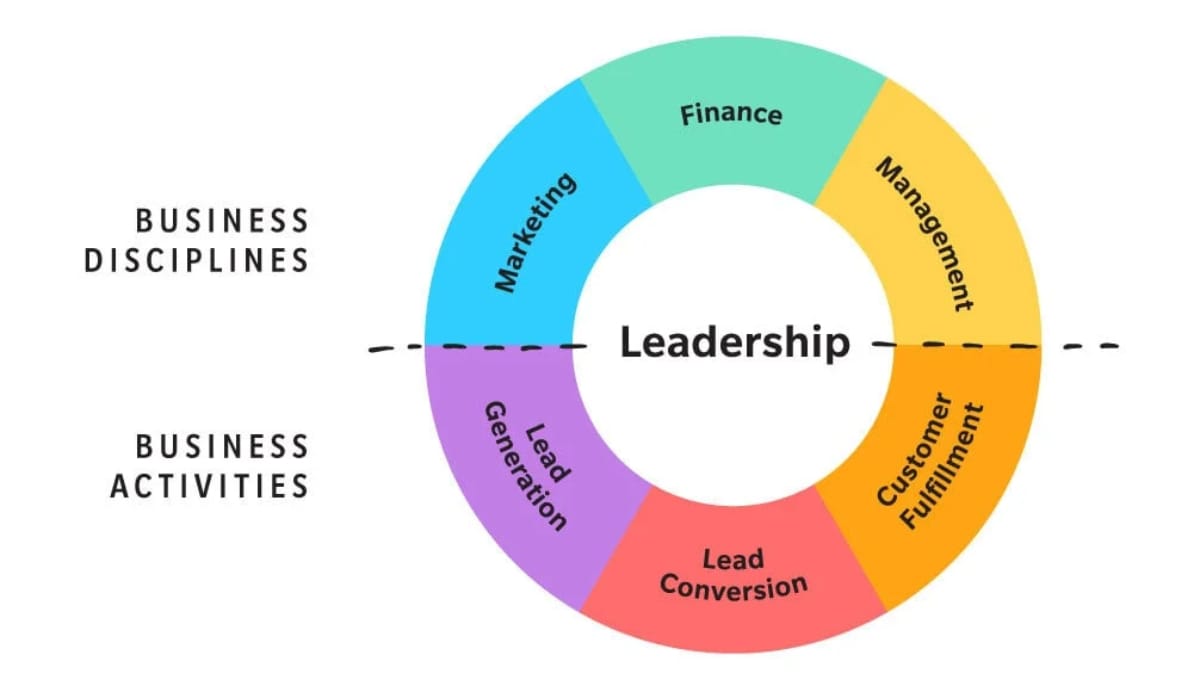[E-Myth] From Technician to Entrepreneur
![Cosmico - [E-Myth] From Technician to Entrepreneur](/content/images/size/w1200/2024/05/emyth_michael_gerber_technician_to_entrepreneur_2024_cosmico_business_tech_insights-1.jpg)
The path to entrepreneurship presents unique challenges, especially for skilled technicians. Michael E. Gerber's "The E-Myth" exposes the myth that technical expertise alone leads to business success. The transition demands a mindset shift from technician to entrepreneur.
Many technicians start businesses based on their trade skills, expecting proficiency to ensure prosperity. However, Gerber argues running a business requires comprehensive understanding beyond operations. This article guides technicians through this transition, leveraging insights from the E-Myth.
We'll explore the essential mindset changes, strategic frameworks, and practical steps to move from technician to successful entrepreneur. Understanding the E-Myth's principles illuminates why technicians struggle with businesses and how to overcome obstacles. Properly equipped, readers can plan, execute, and grow thriving enterprises, avoiding common pitfalls.
Understanding the E-Myth

The Entrepreneurial Myth, or the E-Myth, revolves around the critical mistake that many new business owners make: believing that understanding the technical work of a business means understanding a business that does that technical work. This misconception leads many technicians to open their own businesses with confidence, only to find that running a business involves much more than technical proficiency.
The Myth Explained
Michael E. Gerber emphasizes that the typical small business reflects its founder's mindset, which often focuses on the technical rather than the strategic aspects of the business. A technician who opens a business is likely doing so because they are an excellent plumber, programmer, or designer, not because they understand how to build a business that delivers plumbing, programming, or design services to a market.
For instance, a talented baker might start a bakery because they love baking, and they make delicious pastries. However, their passion for baking does not inherently equip them with the skills to manage inventory, optimize operations, handle marketing, manage finances, or lead employees—skills that are crucial for running a successful bakery.

Misconceptions and Realities
Technicians often fall into the trap of what Gerber calls "an entrepreneurial seizure," where the desire to be their own boss and the illusion of freedom and financial independence lead them to start a business without a clear understanding of what it entails. The harsh reality often hits when they find themselves overwhelmed not only with increasing amounts of work, but with tasks for which they have neither inclination nor skill.
Key misconceptions include:
- If I understand the technical work, I understand the business. Many technicians believe that their technical skills are all they need to run a business effectively. This is rarely the case, as business management involves multiple domains of knowledge.
- Being my own boss means doing only what I like. Freedom is often cited as a major reason for starting a business, but true freedom in business comes from creating a venture that can operate independently of the entrepreneur.
The Need for a New Perspective
To succeed, technicians must adopt a broader view of what a business involves. They need to understand that a successful business is a system of interrelated parts, which includes but is not limited to the technical work. This realization is the first step in transitioning from a technician to an entrepreneur. It involves embracing roles such as the manager, who builds systems and monitors performance, and the entrepreneur, who envisions the future and strategizes on how to get there.
This shift in perspective is critical and forms the foundation of the strategic advice provided by the E-Myth:
"Most entrepreneurs are merely technicians with an entrepreneurial seizure. Most entrepreneurs fail because you are working IN your business rather than ON your business."
This means stepping back from the day-to-day operations and focusing on growth strategies, systematization, and long-term goals.
The Technician’s Mindset

In exploring the transition from technician to entrepreneur, understanding the inherent mindset of a technician is crucial. This mindset, while beneficial in the execution of technical skills, often poses significant barriers when it comes to expanding into the broader horizons of entrepreneurship.
Characteristics of a Technician
Technicians are typically deeply focused on the specifics of their craft. They thrive on the details, the process of creation, and the perfection of their work. This intense focus on the technical aspects is what makes them excellent at what they do, but can also blind them to the larger picture necessary for running a business.
- Detail-Oriented: They excel in tasks that require attention to detail and precision.
- Process-Focused: They are comfortable with routines and established ways of doing things.
- Hands-On Approach: They prefer being directly involved in the work rather than delegating or managing from a distance.
These traits are indispensable for ensuring quality and efficiency in their technical work. However, when stepping into an entrepreneurial role, these same characteristics can become limitations.
Limitations of the Technician Mindset
The technician’s mindset, while a boon for technical precision and expertise, can create significant challenges in the broader scope of business management:
- Resistance to Delegation: Technicians often struggle to delegate tasks because they believe no one else can meet their high standards. This can lead to burnout and a bottleneck in business operations.
- Difficulty in Scaling: A hands-on, detail-focused approach makes it hard to scale a business, as the technician may struggle to step back and allow systems and processes to take precedence.
- Limited Strategic Vision: Being deeply embedded in the day-to-day operations, technicians often miss out on strategic planning, which is essential for long-term business growth and adaptation.
Transitioning to an Entrepreneurial Mindset
For technicians aspiring to become entrepreneurs, it is essential to gradually shift from a predominantly technical focus to a more holistic view of business. This involves:
- Developing Managerial Skills: Learning to manage people, processes, and finances effectively.
- Building Strategic Acumen: Cultivating the ability to think big, set long-term goals, and strategize accordingly.
- Embracing Delegation: Understanding that delegation is key to business growth and learning to trust others to handle aspects of the business.
This transition doesn't mean abandoning the technician's skills, but rather integrating them into a broader skill set that includes managerial and strategic capabilities. The goal is to become a well-rounded leader who can both appreciate the technical work and drive the business forward.
The Entrepreneurial Mindset

As we transition from the technician’s focused and detail-oriented mindset, it's crucial to explore the broader, more dynamic entrepreneurial mindset. This mindset is essential for transforming a technical skill into a thriving business. Understanding and adopting the entrepreneurial mindset allows a technician to step back from the workbench and view their business from a strategic vantage point.
Key Traits of an Entrepreneur
Entrepreneurs are known for certain key traits that enable them to initiate, develop, and expand their businesses effectively. These traits include:
- Visionary Thinking: Entrepreneurs have a clear vision for what they want their business to become. They not only dream big, but also have the ability to set a practical path to achieve their dreams.
- Risk Tolerance: Unlike technicians who may prefer the safety and certainty of their craft, entrepreneurs are comfortable with uncertainty and risks. They make calculated decisions that can lead to high rewards.
- Adaptability: In a constantly changing market, entrepreneurs are quick to adapt their strategies and operations to meet new challenges and opportunities.
- Innovation: They constantly seek new ways to improve their business, whether through innovative products, new business models, or unique marketing strategies.
- Leadership: Effective entrepreneurs are also strong leaders. They inspire their teams, drive change, and are adept at conflict resolution.
Developing these traits can significantly enhance a technician’s ability to successfully manage and grow a business.

Cultivating Entrepreneurial Traits
Transitioning from a technician to an entrepreneur involves intentional development of these traits:
- Setting Clear Goals: Start by defining clear, achievable goals for your business. Visionary thinking can be cultivated by regularly setting and revisiting these goals.
- Embracing Risk: Gradually expose yourself to smaller risks that can lead to significant learning experiences. This helps build the confidence to manage bigger risks.
- Learning to Pivot: Stay alert to industry trends and customer feedback. Use this information to adapt your business strategies, which is crucial for staying relevant and competitive.
- Encouraging Innovation: Allocate time and resources to explore new ideas. This could be in product development, marketing techniques, or customer engagement strategies.
- Developing Leadership Skills: Invest in your personal development by attending leadership workshops, reading relevant books, or getting a mentor. Leadership skills are vital for motivating your team and guiding your business to success.
Integrating New Skills with Technical Expertise
While developing these entrepreneurial traits, it’s important not to discard your technical expertise. Instead, integrate your new skills with your technical knowledge to create a powerful combination that can drive your business to new heights. This integration allows you to maintain the quality and excellence of your technical work while expanding your business's reach and efficiency.
Strategic Frameworks from E-Myth

The insights from Michael E. Gerber's "E-Myth" emphasize the importance of systems in transforming a small business into a scalable, efficient enterprise. A system-based approach enables the business to operate independently of the entrepreneur, which is crucial for growth and sustainability.
"The system runs the business and the people run the system."
Importance of Systems in Business
A system comprises a set of procedures, tools, and methodologies designed to deliver consistent results. It's the backbone of any successful business, ensuring that every aspect of the operation functions smoothly, even in the absence of the business owner. This systematic approach is what separates a self-employed technician from a true entrepreneur who owns a business.
- Consistency and Quality Control: Systems ensure that every product or service delivered meets the business’s standards, regardless of who is performing the work.
- Efficiency and Scalability: Well-designed systems streamline operations and make it easier to scale the business, as they can be replicated and managed with less effort.
- Employee Empowerment: Clear systems and procedures empower employees to perform their duties independently and confidently, reducing the need for constant supervision.
Examples of Successful Systems and Processes
To illustrate the impact of effective systems, consider a bakery owned by a skilled baker who initially managed all aspects of the business. By implementing systems for inventory management, customer service, and baking processes, the baker could delegate daily operations to staff, focus on strategic growth, and ensure that every product sold met their high standards.
- Operational Systems: These include inventory management systems, quality control processes, and standard operating procedures for services and production.
- Financial Systems: Systems for managing cash flow, expenses, and revenue that include automated billing and bookkeeping.
- Marketing Systems: Strategies and tools for consistent brand messaging and customer engagement, such as automated email campaigns and social media management.
Building Your Own Business Systems
Developing effective business systems involves several key steps:
- Identify Key Activities: Break down your business into core activities (e.g., production, sales, customer service) and map out the processes currently in place.
- Standardize Processes: Create detailed, step-by-step procedures for each activity. This standardization is the first step toward automation and delegation.
- Document Everything: Ensure all systems and processes are documented. This documentation will be crucial for training new employees and maintaining quality.
- Implement and Monitor: Put the systems into practice and monitor their effectiveness. Be prepared to make adjustments as necessary to improve efficiency and outcomes.
- Seek Feedback and Iterate: Regularly solicit feedback from employees and customers to identify areas for improvement. Continuous iteration is key to refining systems.
Creating and implementing these systems does not happen overnight. It requires a commitment to continuous improvement and a willingness to adapt and evolve over time.
Planning Your Business

Transitioning from a technician to an entrepreneur involves careful planning to ensure that your business not only survives but thrives. Effective planning sets the stage for operational efficiency, financial stability, and long-term growth. Here, we’ll cover the essential steps and tools needed to create a robust business plan.
Steps to Effectively Plan Your Transition
- Assess Your Current Skills and Resources: Start by evaluating what skills you have and what resources are available to you. This assessment should include technical skills, business management skills, financial resources, and human resources.
- Define Your Business Vision and Objectives: Clearly articulate what you want to achieve with your business. This vision will guide all your strategic decisions and help you set specific, measurable, achievable, relevant, and time-bound (SMART) objectives.
- Market Research: Conduct thorough market research to understand your target audience, identify competitors, and ascertain market trends. This research will help you tailor your products or services to meet market needs effectively.
- Financial Planning: Develop a comprehensive financial plan that includes startup costs, operating expenses, revenue projections, and break-even analysis. This plan will be crucial for managing cash flow and securing financing or investments if needed.
- Legal and Regulatory Compliance: Ensure that you understand and comply with all legal and regulatory requirements related to your business. This includes licenses, permits, and any industry-specific regulations.
- Develop a Marketing Strategy: Plan how you will market your business to your target audience. This strategy should include branding, marketing channels, customer engagement tactics, and key messaging.
- Risk Management: Identify potential risks to your business and ways to mitigate them. This includes financial risks, market risks, operational risks, and compliance risks.

Tools and Resources for Business Planning
Leveraging the right tools can simplify and enhance the planning process. Here are some tools and resources that can help:
- Business Plan Software: Software like LivePlan or BizPlan helps you create detailed and professional business plans with guidance and structure.
- Market Research Tools: Tools such as Statista, Google Trends, or industry-specific databases can provide valuable insights into market dynamics and consumer behavior.
- Financial Management Tools: QuickBooks, FreshDesk, and other accounting software can help you manage your finances effectively, from invoicing to expense tracking.
- Legal Assistance: Websites like LegalZoom or local legal aid organizations can provide resources and advice for meeting your legal obligations.
Planning is not a one-time task but an ongoing process that requires regular updates and adjustments as your business evolves. A well-thought-out business plan not only guides your strategic decisions but also helps communicate your vision to potential investors, partners, and employees.
Executing Your Vision

With a solid business plan in place, the next crucial step is implementing that plan effectively. This stage involves translating your vision and strategy into actionable steps and ensuring that these steps are carried out efficiently to establish and grow your business.
Tips for Implementing Your Business Plan
- Prioritize Tasks: Break your business plan into manageable tasks and prioritize them based on urgency and importance. Focus on completing tasks that will have the most significant impact on your business first.
- Set Milestones: Establish clear milestones to measure progress. These milestones should be specific, measurable, and tied to timelines. They will serve as checkpoints that help you assess whether your business is moving in the right direction.
- Allocate Resources Wisely: Make sure that your resources—be it time, money, or manpower—are allocated efficiently. Invest in areas that will yield the highest returns or are crucial for the operation and growth of your business.
- Leverage Technology: Utilize technology to streamline operations, enhance productivity, and maintain cost-efficiency. From customer relationship management (CRM) systems to e-commerce platforms, the right technology can significantly ease the burden of business management.
- Monitor and Adjust: Regularly review the performance of your business against your plan. Be prepared to make adjustments as necessary to stay on track or to respond to unforeseen circumstances or opportunities.
Common Pitfalls and How to Avoid Them
- Over-Commitment: Taking on too many tasks at once can lead to burnout and subpar outcomes. Focus on what’s essential and consider outsourcing or delegating tasks that are not core to your expertise or critical to your business.
- Underestimating Costs: Many new entrepreneurs underestimate the time and money required to achieve their goals. Always include a contingency budget to cover unexpected expenses.
- Ignoring Customer Feedback: Not listening to your customers can lead to missed opportunities for improvement and growth. Regularly solicit and act on customer feedback to refine your products and services.
- Resisting Change: Being too rigid in your business approach can hinder progress. Stay flexible and open to changing strategies if your initial plans are not yielding the expected results.
- Neglecting Marketing: Failing to invest in marketing can stunt your business's growth. Even the best products or services need effective marketing to reach potential customers.
Executing Your Business Strategy
Execution is where your planning efforts come to fruition. It involves detailed oversight of every aspect of your business operations, constant learning and adaptation, and the effective management of resources and people. By staying committed to your vision while being adaptable to change, you can navigate the complexities of launching and growing your business successfully.
Growing and Scaling the Business

Once your business is up and running, the next critical challenge is growth and scalability. Expanding a business successfully requires strategic planning, the ability to adapt to increasing demands, and the foresight to seize opportunities that align with your vision.
Strategies for Growth and Scaling
- Diversification of Products and Services: Introduce new products or services that complement your existing offerings. This not only attracts new customers but also provides additional value to current customers, potentially increasing customer loyalty and revenue.
- Market Expansion: Explore new markets, whether by entering different geographic areas or targeting different customer segments within your current market. This can increase your customer base and distribute business risks across a broader platform.
- Enhancing Customer Experience: Continuously improve the customer experience by refining your products, optimizing service delivery, and ensuring customer satisfaction. Happy customers are likely to return and recommend your business to others.
- Leveraging Partnerships: Form strategic partnerships with other businesses to expand your reach, share resources, and tap into new customer bases. Partnerships can also enhance your business’s capabilities through shared expertise and technologies.
- Investing in Technology: Adopt advanced technologies that can improve business efficiency and productivity. This can include everything from automation tools in production to sophisticated data analytics for better decision-making.
Case Studies of Successful Business Transitions
- Tech Company Example: A small software development firm initially focused on custom solutions for local businesses. By expanding their offering to include subscription-based generic software products, they were able to scale significantly, reaching a global market.
- Retail Business Example: A local boutique that started with one storefront expanded by establishing an online presence. This move not only increased sales but also diversified their customer base beyond the local community.
Managing Challenges in Scaling
As your business grows, new challenges will emerge that require careful management:
- Maintaining Quality Control: As operations expand, maintaining the quality of your products or services becomes more challenging but increasingly important.
- Managing Increased Overhead: Growth often leads to increased expenses. Efficient management of these costs is crucial to maintaining profitability.
- Human Resources Management: As your team grows, effectively managing staff and maintaining a positive work culture become vital components of your business’s success.
- Supply Chain Complexities: Larger operations can complicate your supply chain. Streamlining these logistics is essential for smooth operations.
Expanding a business requires not just a vision but a strategic approach to execution that balances growth with sustainability. This ensures that the expansion does not overextend the company's resources or stray too far from its core competencies.
Final Thoughts
Transitioning from technician to entrepreneur demands a mindset shift and adopting strategic frameworks. This article explored Michael E. Gerber's "The E-Myth" insights on working on your business, not just in it. We covered embracing an entrepreneurial perspective for vision-driven leadership. Implementing systems ensures efficient, scalable operations. Proper planning lays a solid foundation, while focusing on growth fosters long-term success.
The transition involves continuous learning, adapting business practices and personal development. Persistence and resilience overcome hurdles, while innovation drives improvement. Applying these principles guides decisions and strategies to ensure your business not just survives, but thrives in the marketplace. The journey is iterative and dynamic, requiring a willingness to continuously evolve.
Embarking on this entrepreneurial path with the right mindset and strategies equips you for an enriching journey of challenges, learning opportunities, and significant potential for personal and professional growth. Remember, entrepreneurship demands vision-driven leadership, efficient operations, scalability, and persistent innovation. Embrace these principles as you navigate the exhilarating transition from technician to entrepreneur.
Key Takeaways
| Section | Key Takeaways |
|---|---|
| Understanding the E-Myth | Mastery of a trade doesn't mean you can run a business based on that trade. |
| The Technician’s Mindset | Focus on technical work limits business growth; a broader view is needed. |
| The Entrepreneurial Mindset | Essential traits include vision, risk-taking, adaptability, innovation, and leadership. |
| Strategic Frameworks | Systems and processes are necessary for business efficiency and scalability. |
| Planning Your Business | Comprehensive planning is crucial for laying a solid foundation. |
| Executing Your Vision | Prioritize tasks, use technology wisely, and adjust plans as needed. |
| Growing and Scaling the Business | Expand products, services, and markets to grow. |
| Final Thoughts | Success requires persistence, resilience, and ongoing improvement. |
Top Quotes from E-Myth
- "If your business depends on you, you don't own a business—you have a job. And it's the worst job in the world because you're working for a lunatic!"
- "The purpose of going into business is to get free of a job so you can create jobs for other people."
- "The work we do is a reflection of who we are. If we're sloppy at it, it's because we're sloppy inside. If we're late, it's because we're late inside. If we're bored by it, it's because we're bored inside, with ourselves, not with the work."
- "The system runs the business and the people run the system."
- "People who are exceptionally good in business aren't so because of what they know but because of their insatiable need to know more."
- "The commodity isn't what you sell, it's how you sell it."
- "Innovation is the heart of every exceptional business."
- "Most entrepreneurs are merely technicians with an entrepreneurial seizure. Most entrepreneurs fail because you are working IN your business rather than ON your business."
- "A small business has to be a learning organization. Learning not only from its own mistakes but also from the successes and failures of others."





